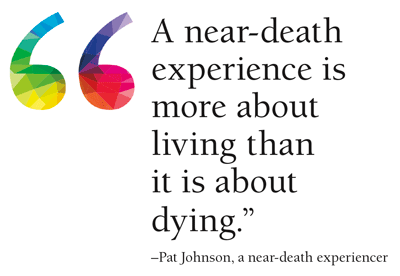Pat Johnson vividly recalls his near-death experience after a boating accident on the Blanco River nearly six years ago. He speaks of that day in reverential tones, of being “in the presence of God” and “at the edge of heaven.”
And he recalls telling his doctor about the experience.
“He basically laughed at me,” Johnson said. “He chuckled and said, ‘Oh, it’s just your frontal lobe shutting down that causes you to have this euphoric feeling and you hallucinate.’ I told him that, no, this wasn’t a hallucination, this wasn’t a dream. ‘It was as real as me standing here talking to you.’ At that point I thought, I don’t care what anyone tells me.”
While near-death experiences are common, so too is the reaction by Johnson’s physician, said Deborah James, M.S.N, RN, CNS, CCRN-K, a clinical assistant professor in the School of Nursing and recognized expert in end-of-life care and near-death experiences.
James, who in 2009 co-authored and co-edited the first compilation of research on the subject, Handbook of Near-Death Experiences: Thirty Years of Investigation, said one in three people who have a close brush with death report a near-death experience.
And James is on a mission to make sure health care professionals, nurses in particular, know how to listen and respond when a patient recounts such a profound experience.
 Over her decades-long career, most spent in intensive care units or other critical care settings, James has met and listened to dozens—if not hundreds—of near-death experiencers, or NDErs. All the stories are different, but there are many common threads.
Over her decades-long career, most spent in intensive care units or other critical care settings, James has met and listened to dozens—if not hundreds—of near-death experiencers, or NDErs. All the stories are different, but there are many common threads.
Johnson’s story begins when he was kayaking with a friend on a swollen river. He was suddenly sucked into a pipe underneath a low-water crossing. Under water, he fought to pull himself out but couldn’t. He was drowning, and soon lost consciousness.
Still, he said, “I felt like I knew where I was at, and I was in a good place. And I thought, I haven’t been that great a person, but I felt like I was in heaven, in the presence of God.”
He sensed “a multitude” of souls around him.
“I didn’t see them but I felt a part of them. I knew they were there.”
And then there was light, “like looking into a kaleidoscope,” Johnson said. “I wanted to get to the light, go to the light.” He was at peace, surrounded by love. “It was beautiful. If I had stayed there, I would’ve been fine with it.”
But somehow the current swept Johnson through the pipe and deposited him downstream, where his friend pulled him to safety and resuscitated him.
As with Johnson’s experience, a common thread is the bright light at the end of a tunnel or hallway, and an extraordinary sense of love and serenity.
“This is not any laughing matter,” James said. “This is not one of those things that people dream up. This is not a dream.”
Years ago, James said, a patient in ICU became irate after he was resuscitated.
“He said, ‘I can’t believe you people made me come back.’ And everybody is like, ‘We did our job. He must be confused.’”
It’s not unusual, she said, for health care professionals and others to consider NDErs to simply be confused, disoriented or trying to get attention.
“What happens many times is those patients get medicated,” James continued. “Health care providers will often order medications because they think the patient is psychotic. Often veterans are treated as if they’re suffering from PTSD.”
So it’s normal for NDErs to be a bit leery of communicating the details of what happened.
“Some people think you’re crazy,” said Johnson, the near-drowning victim. “Almost immediately you develop a sense of who you can talk to about it and who you can’t.”
And if a near-death experiencer is afraid to tell his story or it’s casually dismissed, the person feels rejected, becomes more isolated, more apt to question the experience, and more prone to have self-doubts and fears. They may keep the experience bottled up inside for years.
James, who teaches a variety of courses at the Health Science Center, introduces near-death experiences and the proper response from health care providers whenever she can: while talking about anything from end-of-life or palliative care and hospice to patients coming out of resuscitation.
“As nurses,” James said, “we should listen without judgment. You can tell the difference between someone who is confused and really struggling and someone who’s had a near-death experience.”
More and more health care professionals are responding positively, James said. So are students.
Brittany Jasso, a nursing student who will graduate in May, said nurses should always be open to what near-death experiencers are saying.
“You should ask them to tell you more, like, what did you see, what did you feel,” she said. “I’m not there to minimize their feelings. I’m not there to judge them.”
Despite the skepticism of his doctor, Johnson continues to be enthusiastic about sharing his story, meeting others with similar experiences and seeking a deeper meaning as he gets on with life. And he thinks health care providers are crucial, especially in the beginning, in that search for meaning.
After all, he said, “a near-death experience is more about living than it is about dying.”
